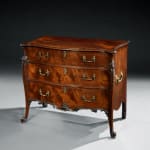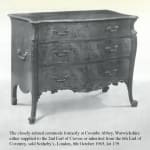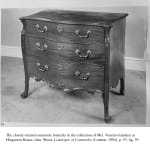Cabinets & Desks
A GEORGE III MAHOGANY COMMODE ATTRIBUTED TO JOHN COBB
Width: 42.25” / 107.3cm
Depth: 25” / 63.5cm
Further images
Provenance
The Collection of Lord and Lady Weinstock
Sold Christie’s, London, 22nd November 2022, Lot 89, GBP £94,500
Literature
Lucy Wood, The Lady Lever Art Gallery: Catalogue of Commodes (London, 1994), pp. 43-53
COMPARE
Only four other commodes of the same model as the present commode are known:
Example formerly in the collection of Mrs. Venetia Gairdner at Hingaston House, illus. Wood, Catalogue of Commodes (London, 1994), p. 53, fig. 39
Example formerly at Coombe Abbey, Warwickshire, sold Sotheby’s, London, 8th October 1965, lot 139
Example formerly with R. A. Lee sold Christie’s, New York, 19th April 2001, Lot 148, USD $446,000
Example in the Metropolitan Museum of Art, New York (Accession No. 64.101.1142)
Publications
A. Coleridge, ‘Sir Lawrence Dundas and Chippendale’, Apollo, September 1976
A Rare George III Serpentine Mahogany Commode Attributed to John Cobb
This exceptional George III serpentine-fronted mahogany commode exemplifies the refined craftsmanship and French-inspired design associated with the distinguished cabinetmaking partnership of William Vile and John Cobb. The shaped and moulded top, segmented and crossbanded, sits above three long, cockbeaded drawers, each retaining their original elaborate foliate brass handles and escutcheons. The boldly keeled stiles are crisply carved with C-scrolls, acanthus, and a tapering string of husks, terminating in distinctive scrolled feet. The front apron is carved with a flowing arrangement of fronds, C-scrolls, and a central foliate clasp, the detailing continuing fluidly into the side aprons and unusually to the back legs, which are pelta-shaped in profile—an idiosyncratic feature of Cobb’s documented work.
This commode belongs to a distinguished group of serpentine-fronted examples attributed to Vile and Cobb, extensively discussed by Lucy Wood in The Catalogue of Commodes (London, 1994), pp. 43–53. Within this broader group, it forms part of a much rarer sub-set of just five known examples of this specific model. The other four are:
-
The example formerly in the collection of Mrs. Venetia Gairdner,
-
That formerly at Coombe Abbey, Warwickshire,
-
The example formerly with R. A. Lee (sold at Christie’s for $446,000), and
-
The example in the collection of The Metropolitan Museum of Art, New York (Acc. No. 64.101.1142).
These commodes are united by their richly carved aprons, scrolled and pelta-shaped profiles, and fine ormolu mounts. Most significantly, they share direct parallels with the documented commode supplied by John Cobb to James West for Alscot Park in 1766, at a cost of £16. That piece serves as the anchor for this group and confirms Cobb’s authorship of the broader type. The hallmarks of Cobb’s workshop—precision carving, curvilinear design, and a particular fluency with the goût pittoresque or French Rococo taste—are all present in the commode offered here.
Cobb was, by the 1760s, among the most accomplished and fashionable cabinetmakers in London. He succeeded his partner William Vile in running their St Martin’s Lane workshop after Vile’s retirement in 1764. Appointed cabinetmaker to George III, Cobb specialised in high-style furniture that drew heavily on the French Rococo idiom, often in the style of Louis XV. He was celebrated for his sophisticated treatment of form and ornament and his judicious use of imported mahogany and ormolu mounts—many of them likely sourced through the same channels as the documented mounts on this commode.
The design of the present commode can be closely aligned with Thomas Chippendale’s Gentleman and Cabinet-Maker’s Director, particularly his 1753 pattern for a ‘French commode table’ (plate XLV in the 1754 edition, renumbered LXVI in 1762). The preparatory drawing for this plate survives in the Metropolitan Museum (Acc. No. 20.40.2(57)), and its influence on the form and ornament of this commode is evident in the scrollwork, knee carving, and sinuous profile.
In both conception and execution, this commode represents the height of English rococo cabinetmaking and stands as a testament to John Cobb’s singular ability to interpret French designs with a distinctly English sensibility. Its rarity, condition, and provenance place it firmly as an important work of mid-eighteenth-century English furniture.





